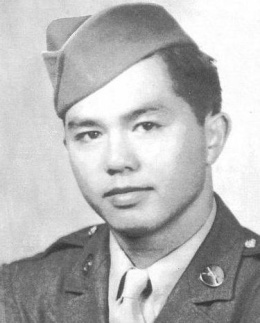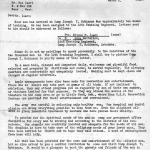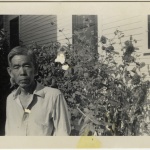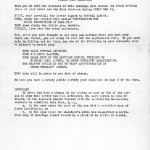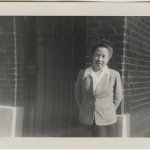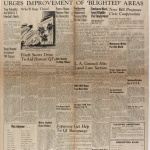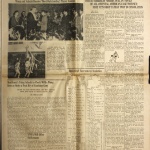Kazuo Masuda
| Name | Kazuo Masuda |
|---|---|
| Born | November 30 1918 |
| Died | 1944 |
| Birth Location | CA |
| Generational Identifier |
Nisei World War II war hero whose story played an important role in the redress movement . A staff sergeant in the 442nd Regimental Combat Team , Kazuo Masuda (1918–44) was killed in action in Italy in 1944. His exploits—and the discrimination his family in California continued to face despite them—received a great deal of publicity at the time and led to his Distinguished Service Cross being personally awarded to the family by General Joseph Stilwell in 1945.
Early Life and Military Service
Kazuo Masuda was born on November 30, 1918, to Gensuke and Tamae Masuda, one of eleven children born into a farming family in California's Orange County. He grew up in Tustin and Fountain Valley, graduating from Fountain Valley Elementary School in 1932 and Huntington Beach High School in 1936. Upon graduation, he worked on the family farm. Like many Nisei, he was drafted after the institution of selective service in 1940 and was inducted on October 16, 1941. At the time of the attack on Pearl Harbor, he was in basic training at Ford Ord.
On December 7, his Issei father was among those arrested and interned, eventually being sent to an internment camp at Fort Missoula , Montana. The rest of his family was caught up in the mass forced removal and incarceration of all Japanese Americans on the West Coast, being sent first to concentration camps Jerome in Arkansas and Gila River in Arizona. Despite this, Kazuo and three of his brothers would serve in the U.S. armed forces.
Like other prewar Nisei inductees, Kazuo spent most of the first two years of his military duty in a sort of limbo, barred from serving on active duty. When the 442nd was formed and Nisei were allowed to bear arms, he was assigned to the "F" Company, 2nd Battalion of the 442nd, training at Camp Shelby. Completing training in February, 1944, he left for combat in Italy in April.
His Distinguished Service Cross citation cites two separate incidents. In early July, his unit advanced against Hill 140 near the town of Pastina. On July 6, he manned an observation post that came under heavy enemy fire. He crawled two hundred yards to secure a mortar tube and twenty rounds of ammunition and then returned to the post. Using his dirt filled helmet as a base, he fired on the enemy for twelve hours, turning back two major counteroffensives and inflicting heaving casualties. On August 27, he led two men on a night patrol across the Arno River in Italy. Finding themselves trapped by the enemy, he ordered his men to withdraw, subsequently taking on the enemy by himself. While his men were able to escape, he was killed by enemy fire. [1]
Postwar Retellings
In January 1945, Japanese Americans were finally allowed to return to their West Coast homes. Mary Masuda, Kazuo's sister, left Gila River to investigate conditions back home before moving the family back. In May of 1945, she reported being approached by five men who threatened her with "bodily harm" unless she moved out of the county. [2] This incident came in the context of dozens of similar incidents aimed at returning Japanese Americans, the majority of them in rural areas. (See Terrorist incidents against West Coast returnees .) Though she left a few days later, more sympathetic members of the community reached out after publicity of the threats, and Mary and the rest of the family were able to return without incident a few weeks later. [3]
In an effort to turn the tide of public opinion on the West Coast and to prevent other incidents, various governmental agencies including the War Relocation Authority (WRA), state law enforcement agencies, and the War Department took various steps ranging from prosecutions of offenders to pro-Japanese American publicity and statements by public officials condemning the threats and violence. The story of Nisei soldiers played a major role in these efforts. The War Department also launched a West Coast speaker program featuring white army veterans who had served with Nisei troops speaking out forcefully against discrimination against returning Japanese Americans. [4]
Seeing the public relations benefits of the Masuda family story, the WRA and War Department recruited General Joseph Stilwell—who had spoken out against the anti-Japanese American violence a couple of months earlier—to present Masuda's Distinguished Service Cross to the family. Flying out just for the event, the ceremony took place on the porch of the Masuda farmhouse as "... newsreel cameras ground, radio mikes edged in and press photographers shot from many angles to record this presentation..." After pinning the DSC on Mary, she said, "In accepting this distinction for my brother, I know that he would want me to say that he was only doing his duty as a soldier of our beloved country." [5]
Later that day, Stilwell appeared at a "United America Day" rally at the nearby Santa Ana Municipal Bowl. Other featured included Hollywood stars such as Robert Young, Will Rogers, Jr, and Louise Allbritton. Young actor and Army Captain Ronald Reagan also spoke, stating
Blood that has soaked into the sands of a beach is all of one color. America stands unique in the world, the only country not founded on race, but on a way—an ideal Not in spite of, but because of our polyglot background, we have had all the strength in the world. That is the American way. Mr. and Mrs. Masuda, just as one member of the family of Americans, speaking to another member I want to say for what you son Kazuo did—Thanks. [6]
Masuda's story would recur one more time in the 1940s. In November 1948, his remains came back to California from Europe. When the family tried to have him buried at the Westminster Memorial Park, they were informed that due to "restrictive covenants," he could only be buried in undesirable locations "where there are no trees or lawn." Public reaction and protest was swift and within a week, the cemetery reversed course and allowed the Masudas a "desirable" plot. [7]
Redress Movement
In the 1980s, a movement to seek reparations and a governmental apology for the exclusion and incarceration of Japanese Americans was coming to a head. Redress legislation had passed the house in September of 1987, and it was clear that it would soon pass in the Senate. Redress organizers turned their attention to President Ronald Reagan, pondering how he might best be convinced to sign the bill when it came to his desk. Grant Ujifusa of the Japanese American Citizens League approached Gov. Thomas Kean of New Jersey, who was able to speak to the President during a visit to New Jersey in October of 1987 and found him open to the possibility, despite mostly being advised by others—most notably by Japanese American and former Republican senator from California S. I. Hayakawa —not to sign it. Kean followed up with a letter that was also accompanied by a letter from June Masuda Goto, the sister of Kazuo, reminding the President of his 1945 statement. [8]
Ultimately, President Reagan did sign what became the Civil Liberties Act of 1988 . In a speech at the signing ceremony, he humorously recalled the Masuda story and his role in it it, alluding to a speech by a "young actor": "The name of that young actor—I hope I pronounce this right—was Ronald Reagan." [9] As redress movement chroniclers Mitch Maki, Harry Kitano and S. Megan Berthold put it, "The use of Kazuo Masuda's story accomplished a great deal. It reminded the president of his personal involvement with the issue and provided him with an anecdote to convey his convictions and values." [10]
On December 17, 1975, the Kazuo Masuda School (now the Kazuo Masuda Middle School) was dedicated in Fountain Valley, California. His story was also featured in a recent book by Russell K. Shoho titled From the Battlefields to the Homefront: The Kazuo Masuda Legacy .
For More Information
442nd Regimental Combat Team Historical Society. "Men of F Company, 2nd Battalion." http://www.the442.org/tributes.html .
Hansen, Arthur A. "Nikkei Agriculture in Orange County, California, the Masuda Farm Family, and the American Way of Redressing Racism." Discover Nikkei , November 23, 2012. http://www.discovernikkei.org/en/journal/2012/11/23/masuda-family-1/
"The Kazuo Masuda Family Story." http://vfwyouthgroup.org/forms/kazuo1.pdf .
Kazuo Masuda Middle School. http://masudams.fvsd.ca.schoolloop.com/ .
Maki, Mitchell T., Harry H.L. Kitano, and S. Megan Berthold. Achieving the Impossible Dream: How Japanese Americans Obtained Redress . Forewords by Robert T. Matsui and Roger Daniels. Urbana: Univeristy of Illinois Press, 1999.
Shoho, Russell K. From the Battlefields to the Homefront: The Kazuo Masuda Legacy . Narrated by Masao Masuda. Foreword by W. Yoshito Thompson. Nikkei Writers Guild, 2009.
United States Department of the Interior, War Relocation Authority. WRA: A Story of Human Conservation . Washington, D.C., 1946. New York: AMS Press, 1975. http://www.internmentarchives.com/showdoc.php?docid=00187&search_id=9036 .
Footnotes
- ↑ His DSC citation can be found at http://www.the442.org/tributes.html , accessed on June 20, 2012.
- ↑ "WRA Acts to Protect Nisei Girl on Coast," Pacific Citizen , May 19, 1945, 3, accessed on Jan. 11, 2018 at http://ddr.densho.org/ddr-pc-17-20/ .
- ↑ United States Department of the Interior, War Relocation Authority, (Washington, D.C., 1946; New York: AMS Press, 1975), 127–28; http://www.internmentarchives.com/showdoc.php?docid=00187&search_id=9036 .
- ↑ WRA: A Story of Human Conservation , 129–30.
- ↑ "General Stilwell Pins DSC on Sister of Nisei Hero in Ceremony at Masuda Ranch," Pacific Citizen , December 15, 1945, 2, accessed on Jan. 11, 2018 at http://ddr.densho.org/ddr-pc-17-50/ .
- ↑ "General Stilwell Pins DCS," 2.
- ↑ "Home Town Cemetery Bars Burial of Nisei War Hero," Pacific Citizen , November 20, 1948, 1, accessed on Jan. 11, 2018 at http://ddr.densho.org/ddr-pc-20-46/ ; "Cemetery Offers Desired Plot for Burial of Nisei GI," Pacific Citizen , November 27, 1948, 1, accessed on Jan. 11, 2018 at http://ddr.densho.org/ddr-pc-20-47/ .
- ↑ Mitchell T. Maki, Harry H.L. Kitano, and S. Megan Berthold, Achieving the Impossible Dream: How Japanese Americans Obtained Redress (Urbana: University of Illinois Press, 1999), 192–93.
- ↑ Maki, et al., "Achieving the Impossible Dream," 196.
- ↑ Ibid., 239.
Last updated Jan. 11, 2018, 10:53 p.m..

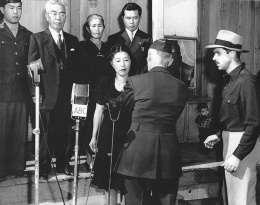 Media
Media
